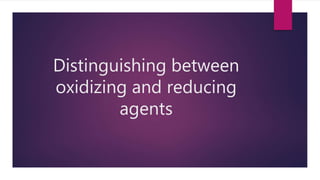
Distinguishing between oxidizing and reducing agents
- 1. Distinguishing between oxidizing and reducing agents
- 2. What is an Oxidizing Agent? An oxidizing agent is a chemical species that tends to oxidize other substances, i.e. cause an increase in the oxidation state of the substance by making it lose electrons.
- 3. As an electron acceptor – They are chemical substances whose atoms remove at least one electron from another atom in a chemical reaction. Oxidizing agents are the reactants that undergo reduction in redox reactions.
- 4. An oxidizing agent is a reactant that brings about oxidation in the other reactant. An oxidizing agent undergoes reduction in the reaction Its oxidation number decreases in the reaction
- 5. What Factors Affect the Oxidizing Power of an Oxidizing Agent? Oxidizing agents normally exist in their highest possible oxidation states and, therefore, have a strong tendency to gain electrons and undergo reduction. Ions, Atoms, and molecules having a strong affinity towards electrons are considered to be good oxidizers. The stronger the electron affinity, the greater the oxidizing power. Elemental fluorine is said to be the strongest elemental oxidizing agent. This is perhaps due to the fact that fluorine is the most electronegative element in the modern periodic table, and therefore exerts the strongest attractive force on electrons amongst all the elements. In fact, the oxidizing power of diatomic fluorine (F2) is strong enough to cause metals such as asbestos and quartz (and even molecules, such as water) to burst into flames when exposed to it. A few other examples of elemental oxidizing agents include diatomic oxygen (O2), diatomic chlorine (Cl2), and ozone (O3). These oxidizers are the elemental forms of the second and the third most electronegative elements (oxygen and chlorine respectively), making them good electron acceptors.
- 7. What are Reducing Agents? A substance which loses electrons to other substances in a redox reaction and gets oxidized to the higher valency state is called a reducing agent.
- 8. • Reducing agents tend to be electron donors. The metals of the s-block in the periodic table are said to be good reducing agents. When some substance is oxidized, it is said to lose electrons and the substance which receives electrons is said to be reduced. If the substance has a strong tendency to lose electrons, then it is said to be a strong reducing agent (since it will reduce the other substances by donating electrons).
- 9. The reducing agent after losing electrons gets oxidized and also causes the opposite reactant to get reduced by supplying electrons. Its oxidation number increases in the reaction
- 10. What Factors Affect the Reducing Power of an Reducing Agent? All the good reducing agents have the atoms which have low electronegativity and a good ability of an atom or a molecule to attract the bonding electrons and the species having very small ionization energies. Due to the smallest standard reduction potential, lithium is the strongest reduction agent. It decreases another substance when something is oxidized, becoming a reduction agent. Lithium is, therefore, the most powerful reducing agent. The highest oxidizing agent is the weakest reducing agent. The species that are lowered in a redox reaction are oxidizing agents.
- 12. Substances that act as both oxidizing and reducing agents
- 13. References https://byjus.com/chemistry/reducing-agent/ https://slidetodoc.com/oxidationreduction-reactions-oxidation-and-reduction- oxygen-transer-a/ https://www.slideserve.com/hadar/redox-reactions Tindale, Ritchie et al, 2014, Chemistry for CSEC 2nd Edition, Nelson Thornes. Chapter 9, p165
